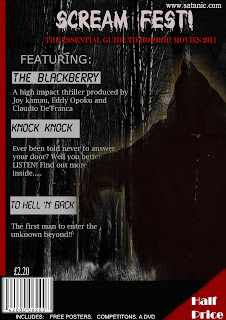The complete evaluation of my advanced portfolio can be found on my prezi:
Prezi Evaluation: http://prezi.com/o_64uqnpxmh5/edmund-opokus-a2-media-advanced-portfolio-evaluation/
About Me
Thursday, 31 March 2011
All three final products
Below is the completion of all three products. These being, Our film trailer "The Blackberry", My film poster and Front Magazine Cover.
Tuesday, 11 January 2011
Audience Theory
In todays media lesson, we looked at "Audience theory" in relation to our final production work.
These are theories that explain how we take in the media all around us and the effects it has on us
It assumes that the audience just sits there and gets injected with non-stop information.
This suggests that the audience does not absorb information directly from the text but is influenced by opinion leaders. Social factors are also seen to be improtant in the reception of media texts.
Uses and Gratification
Stuart Hall- Talk about the encoding/decoding model of relationship between audience and text.
The text is encoded by the producer (meaning inscribed). It is then decoded by the reader (in ways that the producer cannot control).
Niche Marketing
Despite the tendancy to try to reach a large audience for the media text, it is important that we dont forget to look at "narrow casting". It is the oppsite of " Broadcasting"
Audiences
Julian McDougall(2009)- suggests that in the online age, it is getting harder to conceive a media audience as a stable identificable group. However, audiences still clearly makes sense and give meaning to cultural products.
An audience can be described as a "temporary collective" (McQuail 1972)
Leng Ang (1991)
"Audiences only exist as an imaginary entity" - so in other words, we create an imaginaryimage of our targetted audience before we create our product.
Hartley (1987)
Also suggests that institutions must produce "invisisble fictions of audience which allow the institutions to get a sense of who they must enter into relations with"
- We need to look at the ways the audience receives, reads and responds to any media text. This is important for construction and distribution of our productions as well as for collective identity.
- We also look at how to distribute texts in order to attract or reach our target audience. (Advertising package)
These are theories that explain how we take in the media all around us and the effects it has on us
- How the media might influence (or not influence) our behaviour.
- Some theories lead us to think we need more censorship of the media, whilst others might lead us to call for less control.
- Theory helps us to work out the complexity of relationships between audience and texts.
It assumes that the audience just sits there and gets injected with non-stop information.
- Audiences are seen as passive recievers of information transmitted in the text without thinking about them or challenging them.
- People began to see the power of the media to influence and communicate messages - production of propaganda to influence thinkng.
This suggests that the audience does not absorb information directly from the text but is influenced by opinion leaders. Social factors are also seen to be improtant in the reception of media texts.
Uses and Gratification
- Audiences were seen as being made of individuals who were active consumers. Mass is that they did the same thing but in different ways.
- This theory was developed further in in 1974 by Blumer and Kutz
- Diversion-(escape from everyday problems and routines)
- Personal relationship-(Using the media for emotional or other interaction)
- Personal Identity-(Finding yourself reflected in texts, learning behaviour and values for texts)
- Surveillance- ( Finding information which could be useful for living) such as: weather, financial news, holiday information etc.
Stuart Hall- Talk about the encoding/decoding model of relationship between audience and text.
The text is encoded by the producer (meaning inscribed). It is then decoded by the reader (in ways that the producer cannot control).
Niche Marketing
Despite the tendancy to try to reach a large audience for the media text, it is important that we dont forget to look at "narrow casting". It is the oppsite of " Broadcasting"
Audiences
Julian McDougall(2009)- suggests that in the online age, it is getting harder to conceive a media audience as a stable identificable group. However, audiences still clearly makes sense and give meaning to cultural products.
An audience can be described as a "temporary collective" (McQuail 1972)
Leng Ang (1991)
"Audiences only exist as an imaginary entity" - so in other words, we create an imaginaryimage of our targetted audience before we create our product.
Hartley (1987)
Also suggests that institutions must produce "invisisble fictions of audience which allow the institutions to get a sense of who they must enter into relations with"
Subscribe to:
Comments (Atom)

